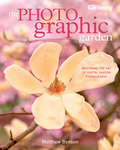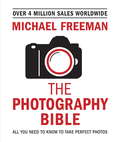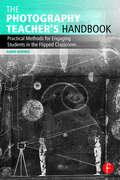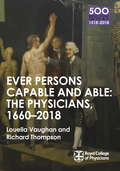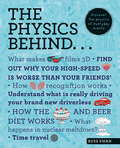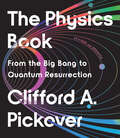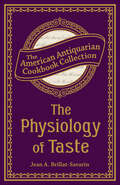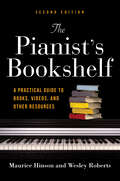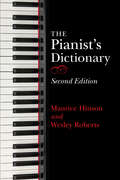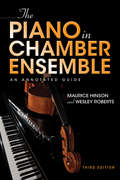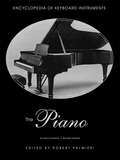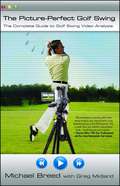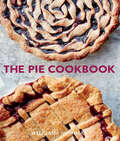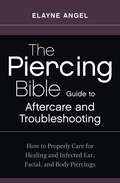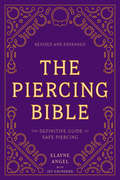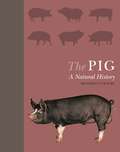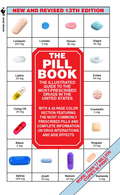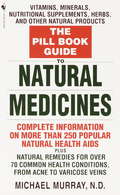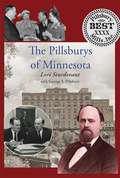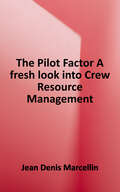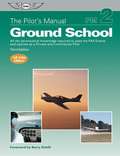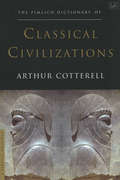- Table View
- List View
The Photographic Garden: Mastering the Art of Digital Garden Photography
by Matthew BensonThe garden is a rich canvas of visual ideas, all waiting to be skillfully captured and evoked by the camera. With in-depth discussions on creative technique and technical literacy, The Photographic Garden is an inspiring guide for understanding the complexities of light and design in the garden and a primer on the latest digital image-making tools, from cameras to postproduction software. Professional photographer Matthew Benson shows you how to become a better, more intuitive artist in the landscape; helps you foster a deeper understanding of design and aesthetics; and encourages you to develop your own visual sensibility—through hundreds of his own thoughtprovoking, evocative garden images. You'll learn how to explore the garden with your camera; how to apply the fundamentals of composition, light, and color to image-making; and how to use digital technology to improve and enhance (and even rescue!) the images you've taken. Most of all, you'll be motivated to see like a camera, work like a professional, and imagine and create like an artist.
The Photography Bible
by Michael FreemanCreated by expert professional photographer Michael Freeman, this convenient book is divided into the four essential areas for photographers to understand; the exposure, light & lighting, composition and editing. It's quick and easy to refer to in the field, by the computerIn a convenient take-anywhere format, this book packs in a lot of value for anyone interested in photography, and without skimping on quality. You'll find how to get great portraits, perfect landscapes and take outstanding artistic compositions; important information whatever camera you choose.
The Photography Teacher's Handbook: Practical Methods for Engaging Students in the Flipped Classroom (Photography Educators Series)
by Garin HornerThe Photography Teacher’s Handbook is an educator’s resource for developing active, flipped learning environments in and out of the photo classroom, featuring ready-to-use methods to increase student engagement and motivation. Using the latest research on the cognitive science of effective learning, this book presents groundbreaking strategies to inspire students to collaborate, explore, and internalize photographic principles and concepts. The innovative practices in this book reimagine the traditional, scholarly pedagogy into a dynamic, teacher-guided, learner-centered approach. Key features include: Step-by-step instructions that explain how and why to flip a photography classroom Hands-on exercises and activities to help students take charge of their learning experience Practical advice from more than 100 respected photography educators An interactive companion website with informative videos, links, and resources for students and educators alike
The Physicians 1660-2018: Ever Persons Capable and Able
by Richard Thompson Louella VaughanThe Royal College of Physicians celebrates its 500th anniversary in 2018, and to observe this landmark is publishing this series of ten books. Each of the books focuses on fifty themed elements that have contributed to making the RCP what it is today, together adding up to 500 reflections on 500 years. Some of the people, ideas, objects and manuscripts featured are directly connected to the College, while others have had an influence that can still be felt in its work.This, the seventh book in the series looks at the history of the Royal College.
The Physicians 1660-2018: Ever Persons Capable and Able (500 Reflections on the RCP, 1518-2018 #7)
by Richard Thompson Louella VaughanThe Royal College of Physicians celebrates its 500th anniversary in 2018, and to observe this landmark is publishing this series of ten books. Each of the books focuses on fifty themed elements that have contributed to making the RCP what it is today, together adding up to 500 reflections on 500 years. Some of the people, ideas, objects and manuscripts featured are directly connected to the College, while others have had an influence that can still be felt in its work.This, the seventh book in the series looks at the history of the Royal College.
The Physics Behind... (The Behind... series)
by Russ SwanCan you really lose weight by consuming nothing but ice cream and beer? How does the latest blockbuster movie get squeezed onto a disk, and how do they make the pictures seem 3D? How much does a selfie weigh? What's the science behind forensic investigations, body scans, and the dating of ancient artefacts?The Physics Behind... takes the reader on a fascinating journey through the scientific principles that that make the modern world work. Could there be life on Mars? Why is north really south? How do self-driving cars find their way around? These and many more topics are explored by starting with the basic science that makes them tick - examining the physics behind them. Packed with detailed original artwork and infographics, The Physics Behind... is perfect for anyone who has ever been curious about the science of life.Including:- The physics behind modern life: Wi-Fi, Facial recognition, touchscreens, microwave ovens, the ice cream and beer diet, taking a selfie, Flash memory, a bag of sugar, catching the train, calendars and clocks- The physics behind entertainment: optical discs, lasers, white water, executive toys, the electric guitar, music, 3D movies- The physics behind analysis: medical imaging, looking at little things, spectroscopy, crime scene investigation, tricorder, microfluidics, radiocarbon dating, proving the Earth is round- The physics behind space: rocket science, space weather, Planet Nine, space telescopes, is there anybody out there? life on Earth, life on Mars- The physics behind big science: what's the matter?, time travel, bomb or meltdown?, the Large Hadron Collider, the Human Genome Project, the Standard Model, gravity, everything- The physics behind the weird universe: strings, rings and other things, N-dimensional space, the hypercube, antimatter, the dark universe, quantum weirdness, quantum biology, time crystals and Majorana- The physics behind the environment: weather forecasts, climate change, renewable energy, migration, peacock feathers, sunburn, rainbows, spider silk- The physics behind transportation: autonomous autos, Hyperloop, Maglev, satellite navigation, motor sport, going rreeaallllyy fast, stealth- The physics behind everything else: curve balls, the Mpemba Effect, why north is really south, perpetual motion and the heat death of the universe, and the physics behind this book.
The Physics Behind...: Discover The Physics Of Everyday Life
by Russ SwanCan you really lose weight by consuming nothing but ice cream and beer? How does the latest blockbuster movie get squeezed onto a disk, and how do they make the pictures seem 3D? How much does a selfie weigh? What's the science behind forensic investigations, body scans, and the dating of ancient artefacts?The Physics Behind... takes the reader on a fascinating journey through the scientific principles that that make the modern world work. Could there be life on Mars? Why is north really south? How do self-driving cars find their way around? These and many more topics are explored by starting with the basic science that makes them tick - examining the physics behind them. Packed with detailed original artwork and infographics, The Physics Behind... is perfect for anyone who has ever been curious about the science of life.Including:- The physics behind modern life: Wi-Fi, Facial recognition, touchscreens, microwave ovens, the ice cream and beer diet, taking a selfie, Flash memory, a bag of sugar, catching the train, calendars and clocks- The physics behind entertainment: optical discs, lasers, white water, executive toys, the electric guitar, music, 3D movies- The physics behind analysis: medical imaging, looking at little things, spectroscopy, crime scene investigation, tricorder, microfluidics, radiocarbon dating, proving the Earth is round- The physics behind space: rocket science, space weather, Planet Nine, space telescopes, is there anybody out there? life on Earth, life on Mars- The physics behind big science: what's the matter?, time travel, bomb or meltdown?, the Large Hadron Collider, the Human Genome Project, the Standard Model, gravity, everything- The physics behind the weird universe: strings, rings and other things, N-dimensional space, the hypercube, antimatter, the dark universe, quantum weirdness, quantum biology, time crystals and Majorana- The physics behind the environment: weather forecasts, climate change, renewable energy, migration, peacock feathers, sunburn, rainbows, spider silk- The physics behind transportation: autonomous autos, Hyperloop, Maglev, satellite navigation, motor sport, going rreeaallllyy fast, stealth- The physics behind everything else: curve balls, the Mpemba Effect, why north is really south, perpetual motion and the heat death of the universe, and the physics behind this book.
The Physics Book: From the Big Bang to Quantum Resurrection (Union Square & Co. Milestones)
by Clifford A. PickoverThis richly illustrated chronology of physics contains more than 250 short, entertaining, and thought-provoking entries. In addition to exploring such engaging topics as dark energy, parallel universes, the Doppler effect, the God particle, and Maxwell's demon, the book's timeline extends back billions of years to the hypothetical Big Bang and forward trillions of years to a time of &“quantum resurrection.&” This reissue includes four new entries: 2012 (Discovery of the Higgs Boson), 2015 (Gravitational Waves), 2019 (First Image of a Black Hole), and 2023 (Milky Way Neutrino Map). It also features an expanded introduction and updates throughout the book.
The Physiology of Taste: Or, Transcendental Gastronomy (American Antiquarian Cookbook Collection)
by Jean Anthelme Brillat-SavarinPerhaps the most influential food writer of his day, Jean Anthelme Brillat-Savarin&’s gastronomic essays are founding documents in the food-writing genre. This great classic of gastronomy is a witty and authoritative compendium on the art of dining, and it has never been out of print since first publication in 1825. The philosophy of Epicurus stands behind every page, and the simplest meal satisfied Brillat-Savarin, as long as it was executed with artistry. The sometimes wordy text is filled with aphorisms and axioms, and it has been endlessly analyzed and quoted. In a series of meditations that have the rhythm of an age of leisured reading and the confident pursuit of educated pleasures. Brillant-Savarin expounds on the delights of eating, which he considers a science, with witty anecdotes and observations such as:&“Those persons who suffer from indigestion, or who become drunk, are utterly ignorant of the true principles of eating and drinking.&”&“A dessert without cheese is like a beautiful woman with only one eye.&”&“Tell me what you eat and I will tell you what you are.&”&“The pleasure of the table belongs to all ages, to all conditions, to all countries, and to all eras; it mingles with all other pleasures, and remains at last to console us for their departure.&” This edition of The Physiology of Taste was reproduced by permission from the volume in the collection of the American Antiquarian Society, Worcester, Massachusetts. Founded in 1812 by Isaiah Thomas, a Revolutionary War patriot and successful printer and publisher, the Society is a research library documenting the life of Americans from the colonial era through 1876. The Society collects, preserves, and makes available as complete a record as possible of the printed materials from the early American experience. The cookbook collection includes approximately 1,100 volumes.
The Physiology of Taste: Or, Transcendental Gastronomy (American Antiquarian Cookbook Collection)
by Jean Anthelme Brillat-SavarinPerhaps the most influential food writer of his day, Jean Anthelme Brillat-Savarin&’s gastronomic essays are founding documents in the food-writing genre. This great classic of gastronomy is a witty and authoritative compendium on the art of dining, and it has never been out of print since first publication in 1825. The philosophy of Epicurus stands behind every page, and the simplest meal satisfied Brillat-Savarin, as long as it was executed with artistry. The sometimes wordy text is filled with aphorisms and axioms, and it has been endlessly analyzed and quoted. In a series of meditations that have the rhythm of an age of leisured reading and the confident pursuit of educated pleasures. Brillant-Savarin expounds on the delights of eating, which he considers a science, with witty anecdotes and observations such as:&“Those persons who suffer from indigestion, or who become drunk, are utterly ignorant of the true principles of eating and drinking.&”&“A dessert without cheese is like a beautiful woman with only one eye.&”&“Tell me what you eat and I will tell you what you are.&”&“The pleasure of the table belongs to all ages, to all conditions, to all countries, and to all eras; it mingles with all other pleasures, and remains at last to console us for their departure.&” This edition of The Physiology of Taste was reproduced by permission from the volume in the collection of the American Antiquarian Society, Worcester, Massachusetts. Founded in 1812 by Isaiah Thomas, a Revolutionary War patriot and successful printer and publisher, the Society is a research library documenting the life of Americans from the colonial era through 1876. The Society collects, preserves, and makes available as complete a record as possible of the printed materials from the early American experience. The cookbook collection includes approximately 1,100 volumes.
The Pianist's Bookshelf, Second Edition: A Practical Guide to Books, Videos, and Other Resources
by Maurice Hinson Wesley RobertsOriginally published in 1997, The Pianist's Bookshelf, was, according to the Library Journal, "a unique and valuable tool." Now rewritten for a modern audience, this second edition expands into the 21st century. A completely revised update, The Pianist's Bookshelf, Second Edition, comes to the rescue of pianists overwhelmed by the abundance of books, videos, and other works about the piano. In this clear, easy-to-use reference book, Maurice Hinson and Wesley Roberts survey hundreds of sources and provide concise, practical annotations for each item, thus saving the reader hours of precious research time. In addition to the main listings of entries, such as "Chamber Music" and "Piano Duet," the book has indexes of authors, composers, and performers.A handy reference from the masters of piano bibliography, The Pianist's Bookshelf, Second Edition, will be an invaluable resource to students, teachers, and musicians.
The Pianist's Dictionary
by Maurice Hinson Wesley RobertsFrom A to Z to middle C: An &“essential reference&” for piano students, teachers, players, and music lovers, with hundreds of definitions (E.L. Lancaster, Alfred Music).The Pianist&’s Dictionary is a handy and practical reference dictionary aimed specifically at pianists, teachers, students, and concertgoers. Prepared by Maurice Hinson and Wesley Roberts, this revised and expanded edition is a compendium of information gleaned from a combined century of piano teaching. Users will find helpful and clear definitions of musical and pianistic terms, performance directions, composers, pianists, famous piano pieces, and piano makers. The authors&’ succinct entries make The Pianist&’s Dictionary the perfect reference for compiling program and liner notes, studying scores, and learning and teaching the instrument. &“This new edition is a go-to source for piano scholars and students for quick information on musical terms, pianists, major works in the piano repertoire, piano manufacturers, and more . . . comprehensive, easy to use.&” —Jane Magrath, University of Oklahoma
The Piano in Chamber Ensemble, Third Edition: An Annotated Guide
by Maurice Hinson Wesley RobertsIn this expanded and updated edition, The Piano in Chamber Ensemble: An Annotated Guide features over 3200 compositions, from duos to octets, by more than 1600 composers. Maurice Hinson and Wesley Roberts catalog published works for piano with two or more instruments with information on performance level, length, individual movements, overall style, and publisher. Divided into sections according to the number and types of instruments involved, The Piano in Chamber Ensemble then subdivides entries according to the actual scoring. Keyboard, string, woodwind, brass, and percussion players and teachers will find a wealth of chamber works from all periods in this invaluable guide.
The Piano: An Encyclopedia
by Robert Palmieri Margaret W. PalmieriFirst Published in 2011. Routledge is an imprint of Taylor & Francis, an informa company.
The Picture-Perfect Golf Swing: The Complete Guide to Golf Swing Video Analysis
by Michael BreedVideo swing analysis revolutionized the way golf is taught, but players have had to rely on teaching professionals to analyze their swing videos -- until now. The Picture-Perfect Golf Swing is the first-ever complete guide to using a digital video camera to develop the perfect golf swing, on your own. One of Golf Magazine's Top 100 Teachers, Michael Breed has long used video analysis to correct the swings of his students. At the core of Breed's teaching approach is the idea that seeing is believing: when you actually see the flaws of your swing, you can truly understand what you are doing wrong, and you can fix the problem more quickly and effectively. By using this book, golfers won't have to rely on professionals to tell them what they're doing wrong -- they can see it for themselves. The Picture-Perfect Golf Swing offers practical guidance for analyzing, assessing, and correcting your mistakes just like a professional -- but without paying a professional rate. Whether as a complement to swing analysis software or on its own, The Picture-Perfect Golf Swing is a must-have tool for everyone using digital video to master their swing. Fully illustrated with photographs showing fundamentally sound swing mechanics, the book also includes instructions on setting up a camera, choosing the best accessories for filming, selecting the correct shutter speed, using a remote control, and much, much more.
The Pie Cookbook
by Williams SonomaFrom the kitchen of America&’s leading home and cookware retailer Williams-Sonoma, a complete reference for making homemade pies from scratch. Packed with over thirty-five recipes, there&’s something for everyone in this compact yet comprehensive cookbook. The Pie Cookbook: Delicious Fruit, Special, & Savory Treats teaches home bakers how to make decadent and delicious treats. Mouthwatering photography, an illustrated how-to section on piecrusts including instructions for creating decorative crusts from fruited to braided to a modern lattice design, as well as tips and tricks for perfect baking, round out this essential title for pie lovers. Fruit Pies: Salted Caramel Apple Pie, Lemon Meringue Pie, Gingered Peach-Blackberry, Cherry Slab, Orange &“Creamsicle&” Special Pies: S&’mores Pie, Grasshopper Pie, Toasted Coconut Cream Pie, Meyer Lemon Buttermilk Chess Pie, Bananas Foster Cream Pie Savory Pies: Shepherd&’s Pie, Tamale Pie, Hot Pockets, Root Vegetable Potpie, Chicken Potpie Try your hand at these delicious recipes and many more with The Pie Cookbook!
The Piercing Bible Guide to Aftercare and Troubleshooting: How to Properly Care for Healing and Infected Ear, Facial, and Body Piercings
by Elayne AngelIn this compilation of chapters on healing and troubleshooting from The Piercing Bible, piercing expert Elayne Angel distills her best advice on caring for new piercings, from cleaning and hygiene to avoiding trauma and infection. It includes healing tips for every type of piercing: · Earlobe · Cartilage · Nose · Eyebrow · Tongue · Navel · Nipple · Genital Elayne has performed more than 40,000 piercings over the course of her professional piercing career, so she's seen it all--including every type of infection. Her troubleshooting tips address the problems that can arise, such as: · Localized infections · Abscesses · Cellulitis · Hypergranulation · Piercing pimples · Discoloration · Scarring · Dry skin · Tarnish tattoos · Dermatitis · Embedded jewelry · Traumatic tears · Rejection and migration With this quick, updated reference, you'll know exactly how to clean and care for your new piercing, no matter what questions you may have.
The Piercing Bible, Revised and Expanded: The Definitive Guide to Safe Piercing
by Elayne AngelEverything you need to know about ear, face, and body piercings—from how to find a skilled professional piercer to best practices for safe healing and optimal results. &“As a piercer, nurse, and educator, I can say without a doubt that this is the most complete book ever written for all people in our industry.&”—David A. Vidra, founder and president of Health Educators, Inc.Piercing expert Elayne Angel has performed over 50,000 piercings since the 1980s and has pioneered many placements, including tongue piercing and the triangle, lorum, and other genital piercings. Her authoritative and groundbreaking guidebook has been the definitive resource on body piercing since its publication in 2009.Many people are unaware of the elevated risks of getting pierced at a mall kiosk, by an untrained tattoo artist, or by a novice piercer; a skilled professional is necessary for safety and optimal results, whether piercing the ear, nose, or elsewhere. This revised and expanded edition is the only comprehensive reference book available to help you navigate the entire piercing process. It contains new illustrations, diagrams, and photos, along with fully updated information, including: • The best piercings and placements for various body parts and body types• Terminology, techniques, and tools of the trade• Vital sterility, sanitation, and hygiene information• Jewelry designs, sizes, materials, and quality• Piercing aftercare and troubleshooting advice for successful healing• How to become a piercer, piercing throughout history and in modern culture, and the future of body piercingThe Piercing Bible, Revised and Expanded, includes essential medical and technical updates, as well as refreshed illustrations and jewelry photography, to reflect today's standards and best practices for safe, professional piercing.
The Pig: A Natural History
by Richard LutwycheA comprehensive, richly illustrated introduction to the fascinating natural history of the pig, from prehistory to the present At any given time, there are around one billion pigs in the world; that's one for every seven of us. And where would we be without them? Prolific, ubiquitous, smart, adaptable, and providers of high-quality protein, pigs have been our companions since neolithic times, when they obligingly domesticated themselves, coming in from the wild to root around our waste pits. But it's not all about the bacon; today, bred in micro sizes, the resourceful pig has developed a whole new career as a popular pet. And thanks to genome mapping, we now know that the pig shares many common physiological features with humans, spurring the use of pig tissue and organs in medical research and surgery. Beautifully designed and illustrated, The Pig provides a snout-to-tail natural history of this important species, from the prehistoric "hell pig" to today's placid porker, covering the pig's evolution and domestication, anatomy and biology, behavior, role in human life and culture, and breeds. The book also features an engrossing and visually stunning photographic gallery of some thirty popular breeds from around the world, with essential information about each. Filled with surprising facts and insights, The Pig will delight anyone who loves these animals and wants to understand them better. Provides a comprehensive, richly illustrated introduction to the pig's evolution and domestication, anatomy and biology, behavior, role in human life and culture, and breeds. Features infographics, diagrams, and 250 stunning color photographs. Includes a beautiful photographic directory to some 30 popular breeds from around the world, with essential information about each
The Pill Book (14th Edition)
by Harold M. SilvermanTHE CONSUMER'S GUIDE TO PILLS--COMPLETELY REVISED 14th EDITION FOR 2010 WITH MORE THAN 20 IMPORTANT NEW DRUGS AND DOZENS OF NEW BRAND NAMES For more than three decades, millions of consumers have trusted The Pill Book to provide official, FDA-approved information on more than 1,800 of the most commonly prescribed drugs in the United States with guidelines from leading pharmacists. Each drug is profiled in a concise, readable, easy-to-understand entry, making The Pill Book the perfect reference when you have questions about the medications your doctor prescribes. Inside you'll discover * generic and brand-name listings that can help you save money* What each drug is for, and how it works* usual dosages, and what to do if a dose is skipped* side effects and possible adverse reactions, highlighted for quick reference* interactions with other drugs and food* overdose and addiction potential* alcohol-free and sugar-free medications* the most popular self-injected medications and their safe handling* information for seniors, pregnant and breast-feeding women, children, and others with special needs* cautions and warnings, and when to call your doctor* 32 pages of actual-size color photographs of prescription pills* No home should be without this book!*Not all ereading devices will show the images in color and at the exact size.
The Pill Book Guide to Natural Medicines
by Michael MurrayIF YOU TAKE NUTRITIONAL SUPPLEMENTS, HERBS, VITAMINS, AND OTHER NATURAL PRODUCTS, YOU NEED THIS BOOK!Compiled by one of America's leading authorities on natural medicine, The Pill Book Guide to Natural Medicines answers vital questions about the effectiveness and safety of more than 250 of today's most popular natural remedies. Dr. Murray's unique A-to-F rating system tells you at a glance whether the product has been scientifically proven to work and if there are risks in taking it. Written in clear, accessible language, here is important information on:* What the product is for, and how it works* Safety and effectiveness rating * Possible side effects* Drug and food interactions* Usual dosage* Cautions and warnings* Special concerns for seniors, children, and pregnant womenUp-to-date and authoritative, The Pill Book Guide to Natural Medicines also contains Dr. Murray's recommendations for the prevention and treatment of over 70 common conditions, from acne and atherosclerosis to ulcers and varicose veins. Remember, just because a product is "natural" does not mean it is safe. This important reference can help you make wise choices-or even save your health.From the Paperback edition.
The Pillsburys of Minnesota
by Lori Sturdevant George S. PillsburyThe Pillsburys of Minnesota "Pillsbury" is a household word in many parts of the world, but in Minnesota it has carried a special import ever since the arrival of John S. Pillsbury, his brother George, and nephews Charles and Fred at the Falls of st. Anthony in the mid-nineteenth century. Here Star Tribune columnist Lori Sturdevant chronicles the family's pioneering role in making Minneapolis the milling capitol of the world. she explores the career of Minnesota governor "Honest John "Pillsbury, and also highlights the instrumental part he played in the growth of the University of Minnesota. Alfred Pillsbury's impact on the Minneapolis Institue of Arts, Philip's remarkable success at reviving a moribund milling giant through the introduction of new food products and George's efforts to fashion a more inclusive Republican Party, are only a few of the many strands woven into the Pillsbury story. From mining camps and insurance companies to arts organizations and charitable concerns, the family's imprint on Minnesota runs deep and wide. Book jacket.
The Pilot Factor: A Fresh Look Into Crew Resource Management
by Jean Denis MarcellinUsing insights from History, Psychology, and Leadership, The Pilot Factor is a new, accessible approach to Crew Resource Management (CRM) that will empower your team to achieve a new level of safety and efficiency by learning or acquiring three key skills: Communication, Leadership and Experience. The concepts are introducing through the use of real stories, making The Pilot Factor an enjoyable yet powerful read. It is not an academic book written for scholars, but rather a down-to-earth, simple book written for pilots to enjoy and learn more about the challenges and tools of a multi-crew cockpit. Although it is written by a Professional Pilot and focused on aviation, the applications of the skills and principles you will learn are boundless. Many other industries' professionals have read and praised The Pilot Factor for its genuine and simple approach to powerful skills that will unlock many skills that can otherwise take a lifetime to acquire through experience alone. The skills and lessons taught cover: - The History of Crew Resource Management (CRM) - The advent of Threat and Error Management (TEM) - Emotional Intelligence and its importance in the cockpit - Communication styles and how to adapt them - A study in Training vs Performance vs Safety - Situational Awareness - Leadership, Management, and how to choose the right tool - Stress management and Decision Making - Debriefing: Learning from mistakes and mitigating Errors Each chapter is approached with a pilot's perspective rather than a teaching perspective, and offers questions that will help remember or quickly review the most important aspects to help pilots get the most from the book.
The Pilot's Manual PM 2: Ground School (Third Edition)
by Pilot's Manual Editorial TeamThe Pilot's Manual: Ground School is designed to develop an in-depth understanding of the main facets of aviation. Not only will it help you pass the Knowledge Exams easily, it will also provide an excellent basis for becoming a competent and safe pilot, regardless of whether you plan to use your skills for personal recreation and travel, or in a full-fledged career as a flight instructor or with the airlines.
The Pimlico Dictionary Of Classical Civilizations
by Arthur CotterellAn original and unique work of reference which breaks new ground by treating for the first time the classical era of the Old World as a whole. Never before have the key peoples and events of Greece, Rome, Persia, India, and China been encompassed in a single volume, despite the fact their civilizations had much in common and laid the foundations of present-day Europe and Asia. Arthur Cotterell asserts that for too long Greece and Rome have been regarded as the classical world and its study isolated from even the major powers that confronted the Greeks and Romans in Iran and India. Today we are more aware of the complex interrelations that once existed between the Greeks and the Persians, the Macedonians and the Indians, the Romans and both the Persians and the Sasanians. The persistent isolation of China, on the other hand, cut off by mountains and deserts from India, makes the classical experience there so useful for comparison and contrast. The virtual absence of slavery in China is but one of its startling features.Comprehensive, wide-ranging and lavishly illustrated, The Pimlico Dictionary of Classical Civilizations provides a fascinating overview and a detailed analyis of the formative period of the world, making it indispensible for both students and the general reader.
